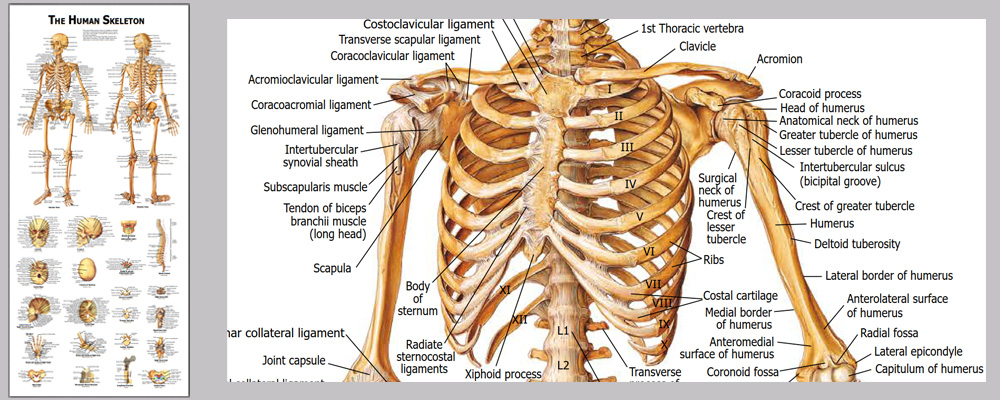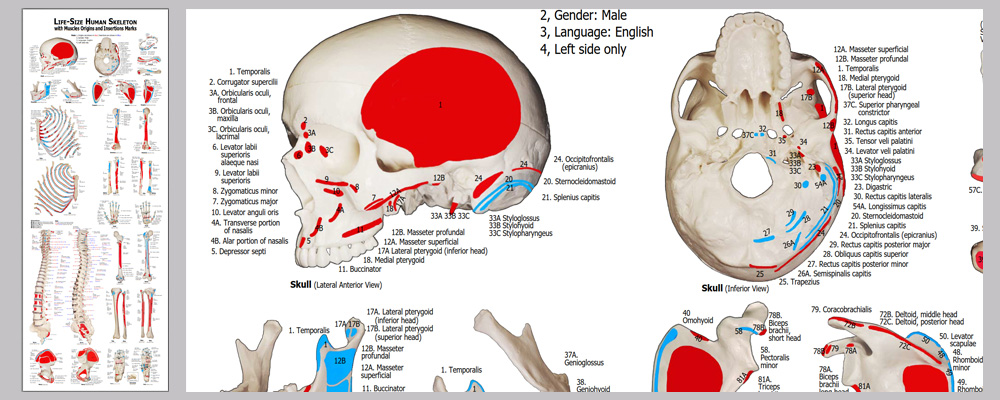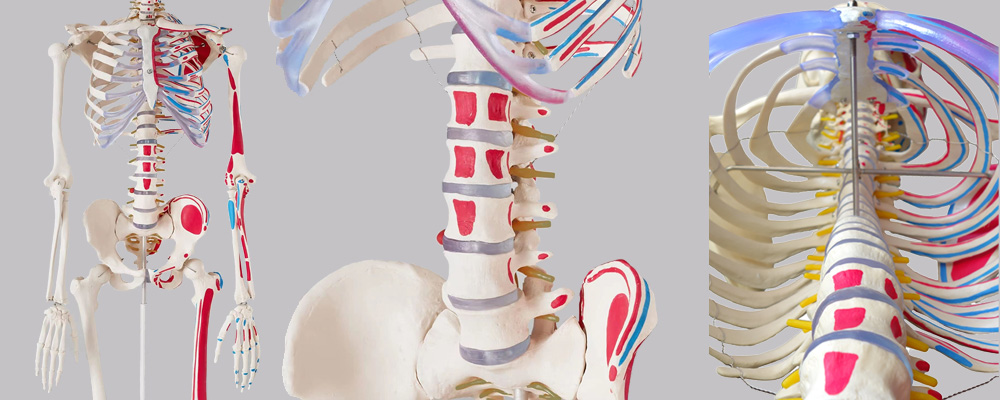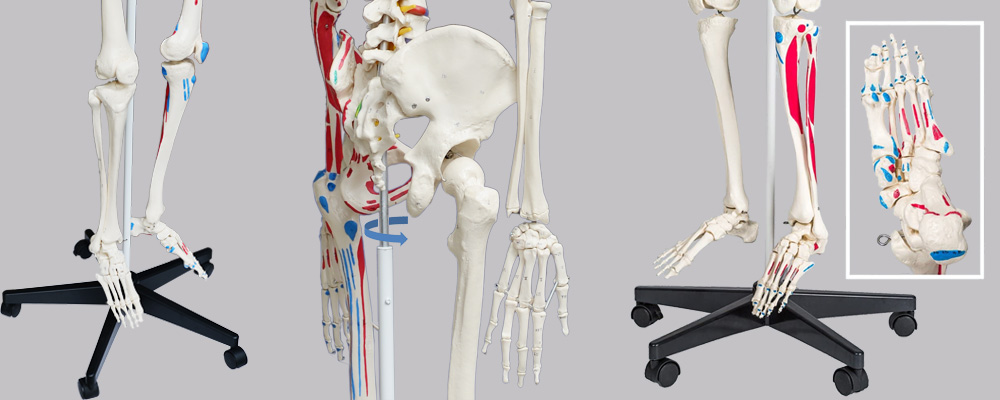anatomic model
This life size articulated adult human skeleton model is 180cm tall & ideal for teaching / learning the basics of human anatomy. Includes a colorful Human Skeleton chart to show all the detailed structures for reference.Detailed colorful chart with over 630 accurate definitions. Durable and no reflection with matte film covered, 36 * 78cm

Detailed muscles origins and insertions with codes. Durable and no reflection with matte film covered, 100cm * 38cm

Stainless steel wires keep the ribs gaps stable.

2 of 5 casters are lockable.

An overview of JC anatomy advantages: • Hand-painted muscle origins and insertions • Flexible spine and ligaments • Slipped disc between the 3rd and 4th lumbar vertebrae • Protruding spinal nerves and vertebral arteries • 3-part assembled skull with individually inserted teeth • Made from a durable, unbreakable synthetic material • Top quality, life size natural casting • lMultiple Applications -Acupuncturists,psychology,psychology, etc. • lChart - Detailed colorful chart with about 780 accurate definitions. Durable and no reflection with matte film covered, 36 * 78cm • On a stable metal stand with 5 casters (painted white) • Full size dust cover keeps model clean while in storage • Exceptional value for money with a 3 year guarantee • anatomic model Easy to use - Main joints are movable. Skull, skullcap arms, legs, crus, feet are removable.
| Product name | anatomic model |
| Place of Origin | Shenzhen China |
| Product Material | PVC, ABS, SST |
| Rib cage | A 5mm dia |
| Human skeleton model life | 17years |
| Surface treatment | Polish. Etched. Texture |
| SUPPORT 24/7 | Contact us 24 hours a day, 7 days a week |
| Size | 96 * 62 * 124 |
| Port | Shenzhen |
| PAYMENT & ORDERING | PayPal account or pay by credit card |
anatomic model FAQs Guide Are you looking for a quick review guide about anatomic model? An ultimate FAQs buying guide is available to help you.This guide contains all the information about all the important facts, figures, and various processes regarding anatomic model. Let’s continue!
2.How to correctly assemble and utilize a anatomic model?
3.Can bone diseases such as osteoporosis be displayed on the anatomic model?
4.How much weight can anatomic model hold?
5.Does the anatomic model have movable joints that can show the range of motion of various parts of the human body?
6.Does the manufacturer of this anatomic model provide relevant anatomy teaching materials?
7.How similar is the anatomic model appearance to a real human skeleton?
8.About anatomic model warranty
1.Can the anatomic model display many different body poses?
The Human skeleton model can display many different body poses in order to show the movement and positioning of bones and muscles. The model can be manipulated into a range of poses such as the classical anatomical position, where the arms are down by the sides, palms facing forward, and feet shoulder-width apart. It can also be posed to demonstrate actions such as walking, running, jumping, and sitting. The flexibility of the model allows for a wide range of movements to be shown, from simple movements of individual joints to complex combinations of actions involving multiple joints. Additionally, the model can display different body poses by adjusting the positions of individual bones and joints. For example, the arms can be raised or lowered, the elbows bent or straightened, and the fingers spread or closed. The legs can be straightened or bent at the knee, and the ankles can be rotated to show different directions of movement. These adjustments allow for a variety of poses to be demonstrated, from relaxed positions to more dynamic and active positions. In summary, the Human skeleton model can display a wide variety of body poses and movements, ranging from simple to complex, to showcase the functions and interactions of the bones and muscles in the human body.
2.How to correctly assemble and utilize a anatomic model?
When assembling and utilizing a human skeleton model, there are several steps to follow to ensure correct positioning and accurate representation of the skeletal system. Below is a step-by-step guide to properly assemble and utilize a human skeleton model: 1. Gather all the necessary components: The first step is to gather all the pieces of the human skeleton model, which typically includes a skull, rib cage, spinal column, arms, and legs. Make sure that all the pieces are present and in good condition. 2. Identify the bones: Before assembling the skeleton, it’s important to familiarize yourself with the different bones and their names. The skull, for example, has different parts such as the cranium, mandible, and maxilla, while the spinal column consists of the cervical, thoracic, lumbar, sacrum, and coccyx vertebrae. 3. Attach the arms and legs: Next, attach the arms and legs to the skeleton. Start by connecting the arms to the shoulder sockets and then attach the hand bones to the arms using the elbow and wrist joints. For the legs, connect the femur (thigh bone) to the hip socket, followed by the tibia and fibula (lower leg bones), and finally the foot bones.
3.Can bone diseases such as osteoporosis be displayed on the anatomic model?
Yes, bone diseases like osteoporosis can be displayed on a human skeleton model. A human skeleton model is a representation of the bones and joints of the human body and can be used to educate and train students and medical professionals. Osteoporosis is a bone disease that results in weakened and porous bones, increasing the risk of fractures. As a result, there are certain features and changes in the bone structure that can be seen on a human skeleton model.
4.How much weight can anatomic model hold?
The amount of weight a human skeleton model can hold depends on the materials used to make it and the structural integrity of the model. Generally, a human skeleton model made from plastic or resin can hold up to 5-10 pounds of weight. However, this weight limit may vary depending on the size and design of the model. If the model is designed to be articulated and movable, it may have a lower weight limit as the joints and connections may not be able to support heavy weights. On the other hand, a solid and non-articulated skeleton model made from sturdy materials such as metal or wood may have a higher weight limit of around 20-30 pounds.
5.Does the anatomic model have movable joints that can show the range of motion of various parts of the human body?
Yes, the human skeleton model typically has movable joints that can show the range of motion of various parts of the human body. These joints are usually represented by different types of articulations such as ball and socket, hinge, saddle, pivot, and gliding joints, which mimic the movement of the actual joints in the human body. For example, the shoulder joint of a human skeleton model will have a ball and socket structure that allows for a wide range of motion, similar to the shoulder joint in a real human body. This joint is able to rotate 360 degrees and can also move forward, backward, and sideways. Similarly, the elbow joint in a human skeleton model will have a hinge structure that allows for flexion and extension movements, just like the elbow joint in a real human body. This enables the model to accurately demonstrate movements such as bending and straightening of the arm.
6.Does the manufacturer of this anatomic model provide relevant anatomy teaching materials?
Yes, we provide a series charts to support teaching and learning
7.How similar is the anatomic model appearance to a real human skeleton?
depending on the level of detail and accuracy that is represented. In general, a well-made human skeleton model will closely resemble a real human skeleton in terms of size, shape, and overall structure. The bones of a human skeleton model are typically made of a strong and durable material such as plastic or resin, and are molded and assembled to accurately represent the bone structure of a real human body. The proportions and dimensions of the bones are also generally accurate, with consideration given to the size and shape of bones in different areas of the body. In addition to the basic bone structure, a human skeleton model may also feature more detailed elements such as muscle attachments and articulations. These details help to further enhance the realism of the model and make it more closely resemble a real human skeleton.
8.About anatomic model warranty
3 years. If any problem occurs with the model due to material or structural defects, it will be repaired or replaced free of charge to the buyer




